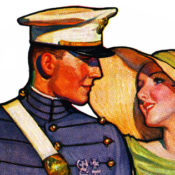
John Clymer began his life on the west coast, but spent much of his career out east working in illustration and advertising. Born in Ellensburg, Washington in 1917, Clymer grew up fascinated by natural art at the foothills of the Cascade Mountains. Over the course of his life, he nurtured his love of nature and eventually became most famous for his depictions of the iconic American west. His parents, John and Elmira Clymer, lived simple lives owning a greenhouse and florist business together.
John was not an academic child. He preferred doodles and staring at the landscape outside the classroom window over paying attention to adults. In his youth, the local Presbyterian pastor halted his own sermon to tell John, who was sitting in the back, to stop drawing in the hymnals.
Covers by John Clymer
Walking on the Fence
John Clymer
December 4, 1954
Fishing on Mountain Lake
John Clymer
July 16, 1955
Rocky Mountain Fly Fishing
John Clymer
May 5, 1956
John’s interest in art began when his parents subscribed to magazines offered by a traveling salesman. At the onslaught of viewing those first professionally illustrated images, John Clymer knew he wanted to be an artist. Since there were no art schools nearby, John joined a federal correspondence course. While still in high school, his friends and classmates encouraged his budding talent. He designed local advertisements for the town rodeo, and even received commissions from Colt Firearms.
Upon graduating high school, Clymer moved up to Vancouver, Canada where he spent eight years illustrating for various Canadian magazines and advertising firms and attending art school classes at night. As his popularity grew, Clymer realized that the most profitable work was on America’s east coast.
In 1932, Clymer married his childhood sweetheart, Doris, and together the two moved to the artist’s colony of Wilmington, Delaware. John went back to school, choosing to study commercial art at the Wilmington Academy of Art. His professors there were some of the greatest names in American illustration, including N.C. Wyeth and Frank Schoonover, each a former student of the great Howard Pyle. After five years there, John and Doris moved to Westport, Connecticut in 1937.
By the 1940s, Clymer’s career on the east coast had taken off. He provided illustrations to such magazines as Argosy, Woman’s Day, Field and Stream, and his first Saturday Evening Post cover on the January 31st, 1942 issue. Clymer created over 80 covers for The Saturday Evening Post between 1942-1962, often portraying patriotic or western scenes.
Once World War II began, Clymer joined the Marine Corps with his artistic partner, Tom Lovell. At age 35, the artists were a little too old to fight on the battlefield. The two were assigned jobs creating illustrations for the Marine Corps magazines Leatherneck and The Marine Corps Gazette.
After the war, John returned home to focus on raising his children and creating new art. Alongside his successful magazine illustration business, John had a large stable of advertising clients including White House Scotch Whiskey, The Pennsylvania Railroad, and The Chrysler Corporation.
With the decline of illustration, Clymer and his wife moved to Jackson Hole, Wyoming in 1970 and stayed there the rest of their lives. He kept a studio out there where he produced paintings of the landscapes and imagined iconic western scenes.
In 1976 he received the prestigious Prix de West Award from the Academy of Western Art. He also received medals from the Cowboy Artists of America, Western Artist of the Year from the National Wildlife Art Collectors Society, and in 1988, he received the Rungius Medal from the National Museum of Wildlife Art.
The artist died in 1989 and has been named a member of the Royal Canadian Academy of Arts. Today, many of his famous paintings and illustrations rest in The Clymer Museum of Art in his original hometown of Ellensburg, Washington.
Become a Saturday Evening Post member and enjoy unlimited access. Subscribe now






